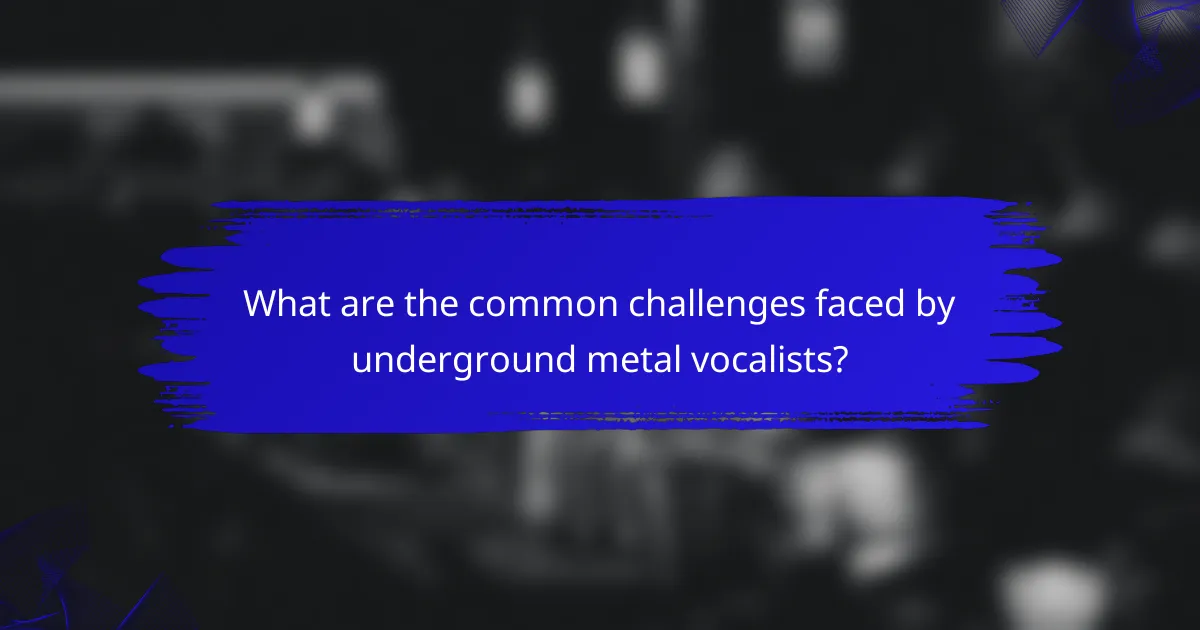Vocal production in underground metal is crucial for achieving intensity and clarity in performances. This article explores essential techniques like breath control and vocal warm-ups, distinctive methods such as growling and screaming, and the impact of equipment choices on sound quality. Additionally, it addresses challenges vocalists face, including vocal strain and the need for unique styles, while highlighting emerging techniques that push creative boundaries.

What are the fundamental techniques for vocal production in underground metal?
Vocal production in underground metal relies on techniques that enhance intensity and clarity. Key methods include breath control, vocal warm-ups, and specific techniques like growling and screaming.
Breath control is essential for sustaining powerful vocals. Singers often practice diaphragmatic breathing to increase their lung capacity and support powerful delivery. Vocal warm-ups prepare the voice, reducing strain and improving range.
Techniques such as growling involve manipulating vocal cord tension and resonance. This unique attribute allows for a distinct sound that resonates within the genre.
Equipment choices, including high-quality microphones and effects pedals, also play a crucial role. Utilizing a dynamic microphone can capture the raw energy of metal vocals, while effects like distortion enhance the overall sound.
How do vocal techniques differ across subgenres?
Vocal techniques in underground metal vary significantly across subgenres, impacting delivery and style. Death metal often employs guttural growls, while black metal favors high-pitched shrieks. Doom metal tends to use deep, resonant tones, contrasting with the aggressive screams of metalcore. Each subgenre’s unique vocal approach enhances its distinct sound and emotional intensity. Equipment choices, such as microphones and effects, further shape these vocal techniques, contributing to the overall aesthetic of the music.
What role does vocal warm-up play in performance quality?
Vocal warm-up significantly enhances performance quality by preparing the voice for demanding techniques. It improves vocal range, stamina, and clarity, which are crucial in underground metal. Effective warm-ups reduce the risk of strain and injury, allowing for more powerful delivery. Regular practice of specific warm-up exercises can lead to noticeable improvements in overall vocal performance.
Which breathing techniques enhance vocal stamina?
Breathing techniques that enhance vocal stamina include diaphragmatic breathing, circular breathing, and controlled exhalation. These methods support sustained vocal production and reduce strain. Diaphragmatic breathing engages the core muscles, providing better airflow. Circular breathing allows continuous sound without breaks, ideal for long passages. Controlled exhalation helps maintain pitch and volume over extended periods. Implementing these techniques can significantly improve performance in underground metal vocal styles.
How can vocalists achieve clarity and power in their delivery?
Vocalists can achieve clarity and power by focusing on breath control, proper vocal technique, and the right equipment. Breath support is essential for maintaining volume and stability. Techniques such as diaphragmatic breathing enhance control. Additionally, investing in quality microphones and sound equipment allows for better sound capture, ensuring clarity in delivery. Using vocal warm-ups and exercises can strengthen the vocal cords, contributing to a more powerful performance.

What equipment is essential for underground metal vocal production?
Essential equipment for underground metal vocal production includes a high-quality microphone, audio interface, and studio monitors. These tools ensure clarity and power in vocal delivery. A dynamic microphone, such as the Shure SM58, captures aggressive vocals effectively. An audio interface with low latency enhances recording quality. Studio monitors provide accurate sound representation for mixing. Additional gear like a pop filter and vocal booth can further improve vocal clarity and isolation.
Which microphones are preferred by underground metal vocalists?
Dynamic microphones are preferred by underground metal vocalists for their durability and ability to handle high sound pressure levels. Popular models include the Shure SM58, known for its reliability, and the Sennheiser e835, which offers clarity and feedback rejection. These microphones typically feature a cardioid pickup pattern, reducing background noise and enhancing vocal presence. Additionally, some vocalists favor the Electro-Voice RE20 for its unique sound profile, providing a smooth frequency response that suits heavy vocal styles.
How does microphone placement affect vocal sound?
Microphone placement significantly impacts vocal sound by altering tonal quality and clarity. Proper positioning can enhance warmth, reduce unwanted background noise, and capture the unique nuances of a vocalist’s style. For instance, placing a microphone closer to the mouth generally increases presence and detail, while positioning it further away can create a more ambient sound. Additionally, experimenting with angles can help in emphasizing certain vocal attributes, such as breathiness or power, which is crucial in underground metal genres.
What role do audio interfaces play in vocal recording?
Audio interfaces are crucial for capturing high-quality vocal recordings in underground metal. They convert analog signals from microphones into digital data, ensuring clarity and detail. A quality audio interface minimizes latency, enhancing real-time monitoring during recording sessions. Features like preamps and phantom power support various microphone types, crucial for achieving desired vocal tones. Additionally, audio interfaces often include software bundles that facilitate mixing and editing, streamlining the production process. Overall, they play an integral role in achieving professional sound quality in vocal production.
Which effects pedals are commonly used for metal vocals?
Common effects pedals for metal vocals include reverb, delay, distortion, and pitch shifters. These pedals enhance vocal presence and aggression, crucial for underground metal.
Reverb adds depth, creating a spacious sound. Delay can create rhythmic echoes, enriching vocal lines. Distortion provides edge and grit, making vocals stand out. Pitch shifters can create harmonies or alter vocal tone, adding uniqueness.
Using these pedals effectively can elevate vocal production, ensuring it complements the heavy instrumentation typical in metal genres.

How do recording techniques impact vocal production quality?
Recording techniques significantly enhance vocal production quality by shaping sound clarity, tone, and emotional impact. Techniques like layering, pitch correction, and dynamic processing contribute to a polished final product. For instance, using multiple mic placements captures diverse vocal nuances, while compression balances volume fluctuations. The choice of equipment, such as high-quality microphones and preamps, also plays a crucial role in preserving vocal integrity. Ultimately, these techniques ensure that the raw energy of underground metal vocals translates effectively in recordings, creating an immersive listening experience.
What are the best practices for recording vocals in a home studio?
To record vocals effectively in a home studio, focus on proper microphone placement, room acoustics, and vocal technique. Start with a quality condenser microphone for clarity and detail. Use pop filters to reduce plosives and ensure a clean signal. Acoustic treatment in your recording space minimizes unwanted reflections, enhancing vocal quality. Finally, maintain a consistent distance from the microphone to achieve balanced levels.
How can layering and harmonization enhance vocal tracks?
Layering and harmonization significantly enhance vocal tracks by adding depth and richness. Layering involves stacking multiple vocal takes, creating a fuller sound. Harmonization introduces additional vocal lines that complement the main melody, enriching the overall texture.
Both techniques allow for creative expression, enabling unique vocal arrangements that resonate within underground metal. Using effects like reverb and delay further enhances this richness, adding atmosphere and dimension. Properly executed, these methods elevate the emotional impact of the music, making it more engaging for listeners.
What mixing techniques are crucial for metal vocals?
Crucial mixing techniques for metal vocals include layering, EQ adjustments, and dynamic processing. Layering enhances depth by combining multiple vocal tracks. EQ adjustments shape the vocal tone, removing unwanted frequencies while emphasizing presence. Dynamic processing, such as compression, controls vocal dynamics, ensuring clarity and consistency in the mix.

What unique vocal styles are prominent in underground metal?
Unique vocal styles in underground metal include guttural growls, high-pitched shrieks, and spoken word elements. These styles enhance emotional expression and differentiate sub-genres like death metal and black metal. Guttural growls often utilize throat techniques, while shrieks may incorporate falsetto. Spoken word adds a narrative quality, enriching the overall sound. Each style reflects the genre’s intensity and complexity, showcasing the vocalists’ technical skills.
How do growling and screaming techniques differ?
Growling and screaming techniques differ primarily in vocal mechanics and sound production. Growling typically involves a low, guttural sound created by manipulating the vocal cords, often resonating from the chest. In contrast, screaming is characterized by a higher pitch and is produced by tightening the throat and using more breath support. Both techniques require practice to avoid vocal strain, but they serve distinct purposes in underground metal music. Growling conveys heaviness, while screaming adds intensity and emotional expression.
What are the vocal characteristics of black metal versus death metal?
Black metal vocals are characterized by high-pitched shrieks and a raw, unpolished sound, while death metal features deep growls and guttural tones. Both genres employ distinct vocal techniques that reflect their unique aesthetics.
Black metal often uses techniques like falsetto and harsh vocalizations, emphasizing atmospheric and emotional expression. The production typically favors a lo-fi approach, enhancing the genre’s dark ambiance. Death metal, in contrast, utilizes techniques such as pig squeals and deep growls, focusing on aggression and intensity. The production tends to be more polished, highlighting the technicality of the instrumentation alongside the vocals.
Equipment choices differ significantly. Black metal vocalists may prefer dynamic microphones for their ability to capture a raw sound, while death metal vocalists often use condenser microphones to accurately record the depth and clarity of growls. These choices influence the overall sonic quality and impact of each genre’s vocal style.
How can vocalists develop their own unique sound?
Vocalists can develop their unique sound through experimentation with techniques and equipment. Emphasizing vocal techniques like growling, screaming, and clean singing allows for diverse expression. Utilizing equipment such as high-quality microphones and effects pedals enhances tonal variation. Exploring different vocal ranges and styles fosters individuality in sound. Engaging in regular practice and seeking feedback from peers can refine their distinctive vocal identity.

What are the common challenges faced by underground metal vocalists?
Underground metal vocalists face several challenges that impact their vocal production. Common issues include vocal strain, limited access to quality equipment, and the need for unique vocal styles.
Vocal strain often arises from aggressive techniques like growling and screaming, which can lead to long-term damage if not performed correctly. Access to quality equipment is crucial; many underground vocalists may not have the budget for professional microphones or sound systems, affecting their sound quality.
Additionally, finding a distinct vocal style can be challenging in a saturated genre, requiring vocalists to experiment with techniques while maintaining vocal health. These challenges necessitate a balance between artistic expression and vocal preservation.
How can vocal strain be prevented during performances?
To prevent vocal strain during performances, singers should focus on proper warm-up techniques, hydration, and equipment choices. Effective warm-ups include vocal exercises that gradually increase in intensity. Staying hydrated maintains vocal cord flexibility. Using quality microphones and sound systems reduces the need for excessive volume, protecting vocal health. Additionally, understanding personal limits and taking regular breaks during rehearsals can help avoid overexertion.
What are the implications of genre expectations on vocal style?
Genre expectations significantly influence vocal style in underground metal, guiding techniques and equipment choices. Vocalists often adopt aggressive techniques like growling or screaming to align with the genre’s intensity. Equipment choices, such as specific microphones and effects pedals, are tailored to enhance these vocal styles. Unique attributes, like the use of distortion, differentiate underground metal from mainstream genres. Additionally, vocal production techniques often focus on rawness and authenticity, reflecting the underground scene’s ethos. This alignment with genre expectations shapes both artistic expression and technical execution in vocal production.
How do vocalists manage stage fright and performance anxiety?
Vocalists manage stage fright and performance anxiety through various techniques and equipment choices. Effective breathing exercises help control anxiety, while warm-up routines prepare the voice. Utilizing supportive equipment, such as high-quality microphones and in-ear monitors, enhances confidence on stage. Visualization techniques and mental rehearsals also play a crucial role in building a positive mindset. Additionally, engaging with the audience and focusing on the music can redirect attention away from anxiety.

What rare techniques are emerging in underground metal vocal production?
Emerging rare techniques in underground metal vocal production include the use of pitch modulation and advanced layering methods. These techniques enhance vocal texture and create unique soundscapes.
Pitch modulation involves varying vocal pitch in real-time, allowing for dynamic expression. Advanced layering techniques combine multiple vocal tracks with varying effects, resulting in a fuller sound.
Additionally, the incorporation of unconventional vocal effects, such as granular synthesis, is gaining traction. This method manipulates vocal samples into intricate patterns, pushing creative boundaries.
These innovations reflect a growing trend towards experimentation in underground metal, emphasizing individuality and sonic exploration.
How is technology influencing vocal production in underground metal?
Technology significantly enhances vocal production in underground metal by providing advanced tools and techniques. Digital audio workstations allow for intricate layering of vocals, enabling unique soundscapes. Vocal effects like pitch correction and distortion are widely used, allowing artists to create signature styles. Additionally, home studio setups have become more accessible, empowering musicians to produce high-quality recordings independently. This shift democratizes production, fostering innovation within the genre.
What experimental vocal techniques are gaining popularity?
Experimental vocal techniques gaining popularity in underground metal include throat singing, growling, and extended vocal techniques. These methods enhance expressiveness and create unique soundscapes. Throat singing, originating from various cultures, allows for harmonic overtones. Growling provides a raw, aggressive tone, while extended techniques like multiphonics add complexity. Musicians are increasingly incorporating these styles to push creative boundaries.
How can vocalists incorporate non-traditional sounds into their performances?
Vocalists can incorporate non-traditional sounds by experimenting with unconventional techniques and equipment. Techniques like throat singing, overtone singing, and vocal distortion can create unique soundscapes. Equipment choices such as loop pedals, vocal effects processors, and unconventional microphones enhance these sounds. Additionally, blending genres and collaborating with sound artists can introduce fresh elements to performances. This approach allows vocalists to push boundaries and create a distinctive auditory experience.
What are the best practices for maintaining vocal health?
To maintain vocal health in underground metal, focus on hydration, proper warm-ups, and vocal rest. Use techniques like diaphragmatic breathing and avoid straining the voice. Regularly assess equipment choices, ensuring microphones and monitors suit your vocal style. Invest in quality gear to reduce vocal fatigue.